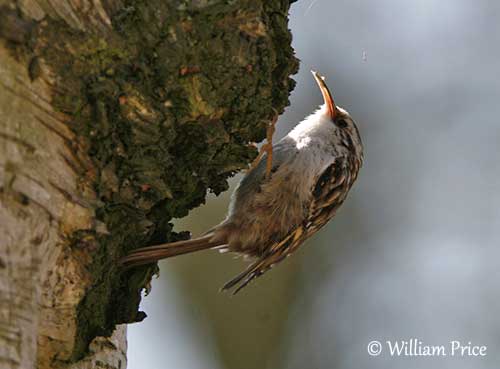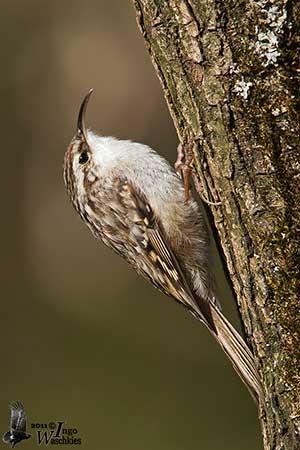
Fr: Grimpereau des jardins
Ang: Short-toed Treecreeper
All: Gartenbaumläufer
Esp: Agateador Europeo
Ita: Rampichino comune
Nd: Boomkruiper
Sd: trädgårdsträdkrypare
Photographers:
Jean Michel Fenerole
Photos d’Oiseaux du monde
Otto Plantema
Trips around the world
William Price
PBase-tereksandpiper & Flickr William Price
Ingo Waschkies
Bird Photography
Nicole Bouglouan
Photographic ramble
Text by Nicole Bouglouan
Sources:
HANDBOOK OF THE BIRDS OF THE WORLD Vol 13 by Josep del Hoyo-Andrew Elliot-Jordi Sargatal - Lynx Edicions – ISBN: 9788496553453
THE HANDBOOK OF BIRD IDENTIFICATION FOR EUROPE AND THE WESTERN PALEARCTIC by Mark Beaman, Steve Madge - C. Helm - ISBN: 0713639601
ENCYCLOPEDIE DES OISEAUX DE FRANCE ET D’EUROPE – de Peter Hayman et Rob Hume - Flammarion – ISBN : 2082009920
L’ENCYCLOPEDIE MONDIALE DES OISEAUX - Dr Christopher M. Perrins - BORDAS - ISBN: 2040185607
LE GUIDE ORNITHO par Grant, Mullarney, Svensson, Zetterström - Delachaux Niestle - ISBN: 2603011421
Short-toed Treecreeper - Javier Blasco-Zumeta & Gerd-Michael Heinze
Arthur Grosset's Birds (Arthur Grosset)
Wikipedia, the free encyclopaedia
Short-toed Treecreeper
Certhia brachydactyla
Passeriformes Order – Certhiidae Family
INTRODUCTION:
The Short-toed Treecreeper is resident across Europe, from Portugal to Turkey and Greece, and also in NW Africa.
It breeds in temperate forests with mature trees usually in lowlands, but it breeds locally between 900 and 1,800 metres of elevation.
It feeds mainly on invertebrates and forages on tree trunks where the long, thin bill extracts insects from the bark crevices. Some prey can be caught on the ground.
The Short-toed Treecreeper nests in crevices in tree trunks or behind bark flakes, and it may also use artificial nest boxes. Both adults share the nesting duties.
The Short-toed Treecreeper is very similar to the Eurasian Treecreeper (C. familiaris), and it is often difficult to identify them. However, their songs are different and allow sometimes to know what species is singing. But recent genetic studies indicate that the Short-toed Treecreeper is closest to the Brown Creeper or American Treecreeper (C. Americana).
Currently, the Short-toed Treecreeper is not globally threatened.

DESCRIPTION OF THE BIRD:
Biometrics:
Length: 12-13 cm
Weight: 7,5-11 gr
The Short-toed Treecreeper has very cryptic plumage, making the bird difficult to find while foraging on tree trunks.
The upperparts are brown with white streaks, but mantle and scapular feathers show blackish tips and broad white centres, involving well-defined streaking. Rump and uppertail-coverts are cinnamon-rufous with whitish feathers centres and indistinct blackish bases.
On the upperwing, the lesser coverts are brown with orange-buff tips. Both median and greater coverts are blackish-brown. Median coverts have orange-buff tips and whitish centres, whereas greater coverts are edged and tipped pale buff to rufous-brown. Primary coverts are black-brown with pale buff tips. The alula is similar but with pale fringe on the outer web.
Primary and secondary flight-feathers are brownish, but 3-4 outer primaries show a pale buff band across the feathers and a blackish-brown band on each side. They are fringed orange-buff and tipped white. The tertials have pale brown inner webs and dark brown outer webs, and broad white tips.
The tail is pale brown with pale rufous-brown shafts. The 12 rectrices are stiffened with robust shafts projecting at the tip.
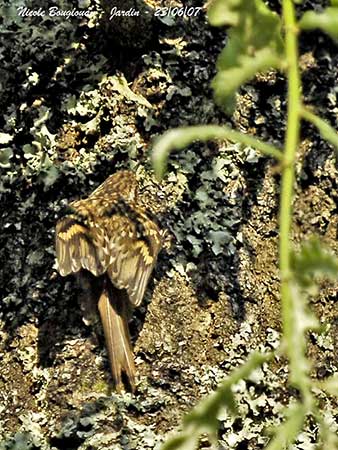
The underparts are greyish-white to pale grey, but breast, belly and flanks are washed rufous-brown to brown. The undertail-coverts are pale rufous-brown with whitish tips. The thighs are pale grey.
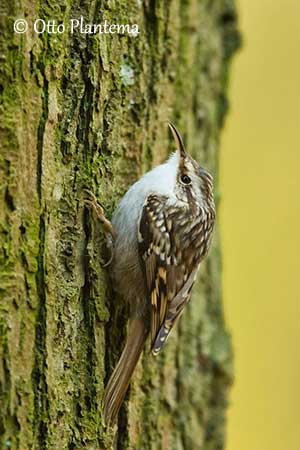
On the head, crown and nape are dark brown with blackish fringes and narrow white shaft streaks. The lores are blackish. The supercilium is greyish/brownish-white. It is often absent in front of the eye.
The long, thin, downcurved bill has dark brown upper mandible and paler brown lower mandible with dark tip. The eyes are brown. Legs and feet are pale brown.
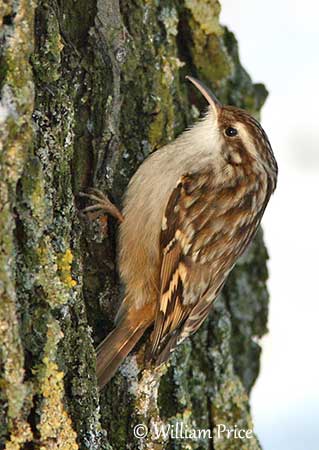
Male and female are similar, although the male has longer wings and bill.
The juvenile resembles adult, but the upperparts are white-spotted rather than streaked. Below, breast, flanks and belly are often speckled with grey or buff, but the colour appears fairly uniform.
SUBSPECIES AND RANGE:
The Short-toed Treecreeper has five subspecies.
C.b. brachydactyla is found in Continental Europe in S, C and SE Europe, from SE Spain to Turkey.
The former race “harterti” of NW Turkey, and “stresemanni” of N Turkey, are now included in nominate.
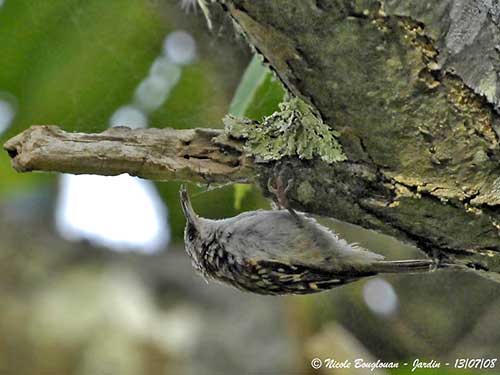
C.b. megarhynchos is found in W Europe, from Portugal and NW Spain to W and N France and W Germany.
This race is slightly paler and warmer brown than nominate.
C.b. mauritanica occurs in NW Africa in Morocco, Algeria and NW Tunisia.
This one resembles nominate with slightly darker upperparts, pale streaked crown with narrower and less conspicuous streaks, less whitish underparts with breast and flanks more extensively washed buff.
C.b. dorotheae is found in S Greece and Cyprus.
This race is slightly duller greyish/brownish above and the bill is longer.
C.b. rossocaucasica is in NW Caucasus (formerly race “harterti”).
HABITAT:
The Short-toed Treecreeper frequents deciduous, mixed and coniferous forests, and especially edge habitats and riverine trees with willows (Salix) and poplars (Populus), large gardens, orchards and parks with dense understorey. In many areas, it favours oak and pine woods. This species needs primarily stands of mature, rough-barked trees.
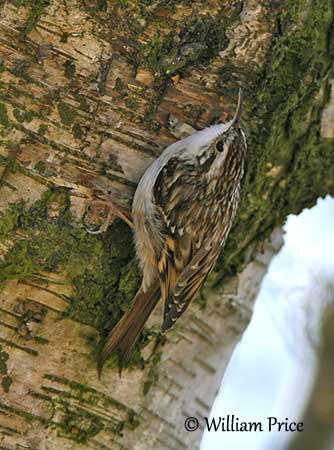
The Short-toed Treecreeper can be found at high elevations depending on the range, below 1,000 metres in northern range whereas in the southern part, it occurs up to 1,400/1,800/2,000 metres of elevation.
In cold weather, several birds may roost together in sheltered crevices in tree trunks.
CALLS AND SONGS: SOUNDS BY XENO-CANTO
The Short-toed Treecreeper gives a high, shrill, piping “zeet” when excited or alarmed. This call is usually given in slow or rapid series.
A high, thin “tsrree” is used as contact call. It is very similar to Eurasian Treecreeper’s call but slightly lower, louder and more tit-like. The flight call is a short, sharp “si” also similar to Eurasian Treecreeper.
However, the songs of these species differ. The song of the present species consists of several loud, rather plaintive whistles uttered with jolting rhythm and rising at the end “seet seet seet-e-roi deITT”.
The race “mauritanica” has lower-pitched song.
BEHAVIOUR IN THE WILD:
The Short-toed Treecreeper feeds mainly on a variety of invertebrates including insects (larvae and pupae) and spiders. These food items are usually found in bark crevices on tree trunks.
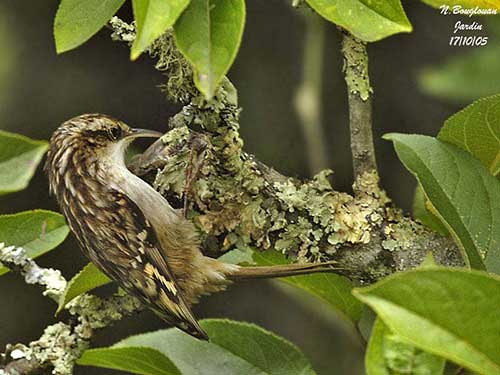
The bird forages by starting near the base of the trunk and then, spiralling up. It uses the stiff tail feathers for support and the long claws to progress upwards along the trunk, like the woodpeckers. However, it does not descend head first like a nuthatch but flies down to the base of another tree and spirals up again.
The prey are caught with the long, thin, decurved bill. It may occasionally forage on walls, on the bare ground or among the pine needles. During winter, some small seeds are also consumed.
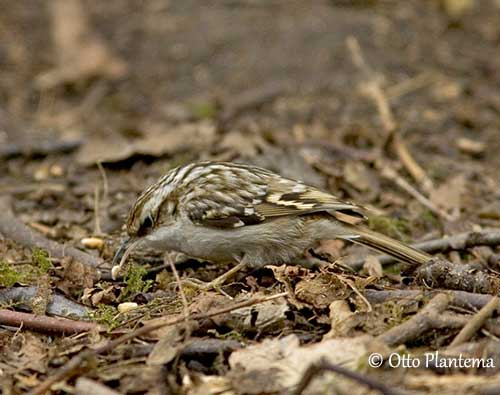
During the breeding season, the territory of the Short-toed Treecreeper is established even in small groups of trees with rugged bark, also in orchards or parks and at edges of forest with broad lived and mixed tree species. The territories are often clumped, but with some unoccupied areas between groups of territories, involving overlapping with neighbour’s territories.
In this type of distribution, each male establishes and keeps its own area during permanent vocal contacts with the neighbours, involving frequent movements and chases to keep other males away from its own territory.
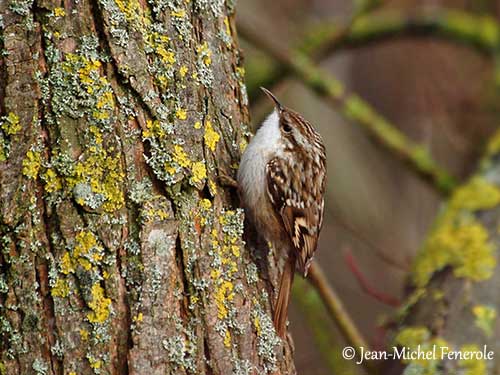
The courtship displays involve excited chases, with the male pursuing the female while spiralling up and down the tree trunks. Then, one or both mates may raise the wings and flutter them rapidly. These displays are usually followed by other chases and/or by courtship feeding by male to female.
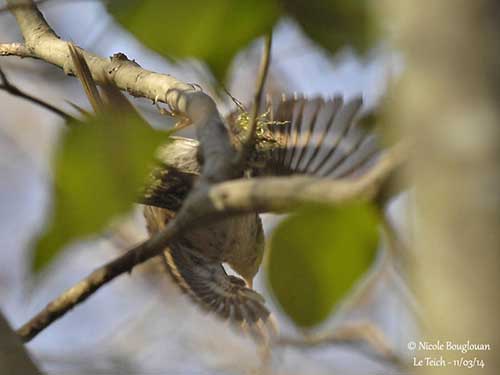
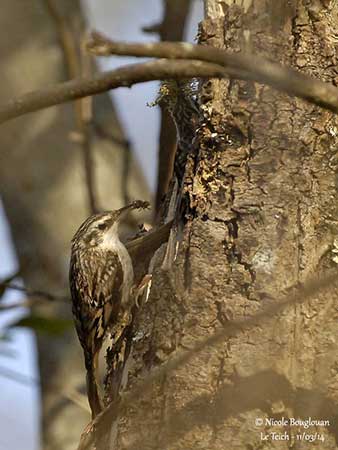
Pair at nest entrance
The female (top) has some moss in her bill and she builds the nest. The male comes to give her an insect..
This behaviour takes place outside the nest. The female with fluttering wings begs food like a juvenile. The male lands above her and places the food in the throat of the female.
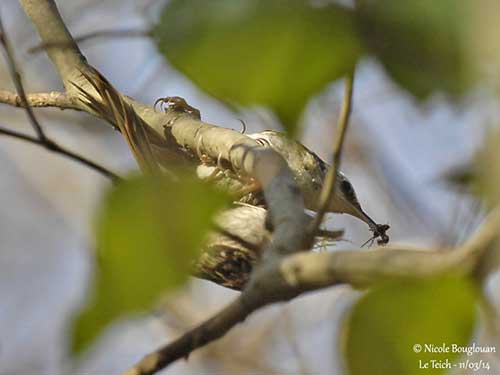
The Short-toed Treecreeper usually produces two broods per season. The male builds two or three nest foundations and after selecting one of them, the female completes the structure. This work takes up to a month.
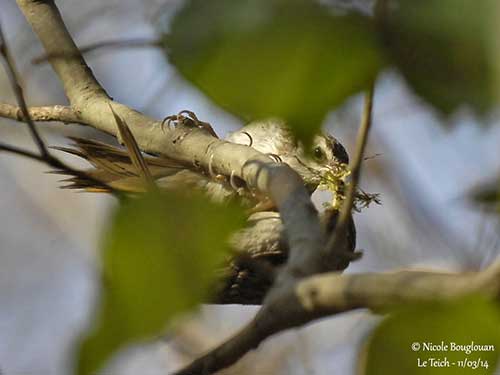
The Short-toed Treecreeper is non-migratory, although some post-breeding dispersal is reported. The species is vagrant in England, Sweden, Lithuania and the Balearic Islands.
The flight of the Short-toed Treecreeper is erratic and undulating, with butterfly-like wingbeats interspersed with side-slips and tumbles in the air.
REPRODUCTION OF THIS SPECIES:
The breeding season takes place from late March/early April to mid-June.
The Short-toed Treecreeper nests in tree crevices or behind bark flakes, but abandoned woodpecker holes, cavities in buildings, woodpiles, base of nests of other species (raptors or squirrels) and sometimes nest-boxes are also used.
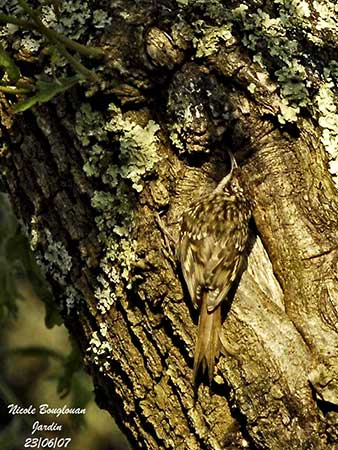
The male starts to build two or three nest foundations, but the female selects one of them and completes the nest-building. The nest base is made with twigs, conifer needles, grass and bark, with a lining of softer material such as feathers, moss, lichens, spider web, and also wool, paper, vegetal fibres, rootlets or down. Most nests are built between 50 cm and 4 metres above the ground, rarely above 10 metres.
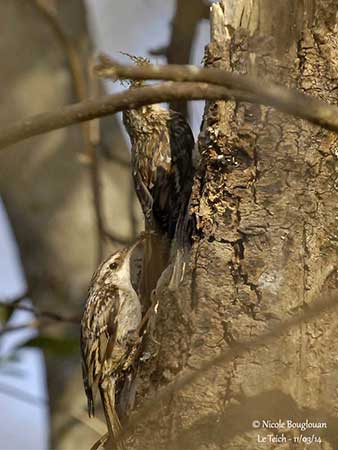
The female lays 4-9, usually 5-7 white eggs with darker blotches and spots. She incubates during 13-15 days. She broods the chicks which are fed by both parents. They fledge 15-18 days after hatching and probably disperse quickly.
A new nest may be started while the female continues to feed the first brood. A second clutch is sometimes laid before the first young have fledged.
PROTECTION /THREATS / STATUS:
The Short-toed Treecreeper is usually fairly common, although being scarce in N and E of the range and rare in Caucasus.
However, the intensive forestry activities with in addition the replacement of deciduous woodlands with conifer plantations involve the disappearance of the mature forests and have a negative impact on populations.
The European population is estimated at 10,300,000/17,400,000 mature individuals (2015). As Europe is about 90% of the range, the global population is roughly estimated at 11,000,000/19,000,000 mature individuals.
A moderate increase has been reported between 1982 and 2013 in Europe.
The Short-toed Treecreeper is not globally threatened, and currently evaluated as Least Concern.
